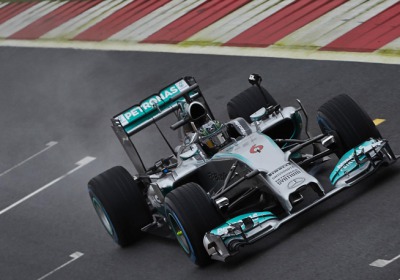F1 2014: the six big engine questions
Fri, 14 Mar 2014By Tom Clarkson
First Official Pictures
14 March 2014 11:30
The workload has never been greater for Formula One’s 11 teams. They’re finalising preparations for the biggest shake-up in F1's technical regulations this century.
A new engine formula for 2014 will see the current 2.4-litre naturally aspirated V8 replaced by a turbocharged 1.6-litre V6 with a much greater dependency on energy recovery (ERS).
Engine power will remain roughly the same, but the power delivery and the packaging of the new engine will be completely different.
‘We had a lot of different development programmes going on,’ says McLaren technical director Paddy Lowe. ‘Alongside the work on the 2013 car, which we launched at the end of January, we had to run a parallel development programme for the 2014 rules. There’s a lot to look into: the energy recovery, packaging, new aerodynamic rules – and other smaller changes. We increased the amount of resource given to 2014 as the year progresses.’
Three engine manufacturers – Ferrari, Mercedes and Renault – already have V6 turbos running on their dynos, and two more (Honda and Porsche) are believed to have R&D programmes on the go. CAR was given a sneak preview of Mercedes’ V6; here’s what we learnt.
Power output will be similar, at around 750bhp, but the V6 will have more torque thanks to the turbo (which will be limited to 125,000rpm). The new engine will be limited to 15,000rpm, compared with 18,000rpm for the V8, but fewer revs won’t mean less performance.
‘The 2014 cars will have more power than grip at corner exit, so we should see lots of power oversteer,’ says Andy Cowell, boss of Mercedes High Performance Powertrains. ‘The cars will be spectacular to watch, and the rules are a good technological challenge. With these new power units, F1 is putting the “motor” back into motorsport.’
The combination of oversteer on corner exit, 33 seconds of ERS deployment per lap and reduced fuel consumption should keep F1 predictably unpredictable. The biggest threat to the on-track action is if one manufacturer steals a march on its rivals early on, but even if that’s the case there will be at least three teams using each engine.
The V6s had to be homologated on 1 March 2014, but the FIA has said it will allow those who aren’t quite on the money to make small adjustments to catch up. When the V8s arrived in 2006, we had a thrilling title fight between Alonso and Schumacher, and there’s no reason that can’t happen again.
The engine will be a tad quieter than the current V8 due to the turbo and the lower rev limit, but it will still produce a deafening roar because all six cylinders will run into a single tailpipe.
‘People like loud cars,’ says new Mercedes driver Lewis Hamilton. ‘It’s important that the cars retain their current levels of noise.’ Having heard the engine running at Brixworth, CAR can confirm that there’s nothing to worry about!
Think Alain Prost in the mid-’80s because F1 will once again be geared towards the thinking driver. For example, those who are less aggressive with the throttle will gain through fuel consumption and tyre wear, which could be critical if the predicted wheelspin materialises. There’s also the question of utilising the increased horsepower from the ERS for 33 seconds per lap. It all points towards the most intelligent drivers doing best.
Yes, although the governing body has decided to delay the introduction of an ‘electric pitlane’ until 2017. Fuel efficiency will be the biggest environmental gain because the 2014 engines will be limited to 100kg of fuel per hour – 30% less than in ’13. There will also be a new and improved Energy Recovery System. The current KERS system gives the drivers an 80bhp boost for 6.7s per lap; in 2014 they will have an extra 161bhp for 33.3s per lap. There will also be a greater onus on reliability because each driver will have just five power units per season – three less than the current limit of eight.
The outgoing V8 was introduced in 2006, with no limit to the amount of development that could be carried out by the manufacturers. Huge gains were made, the likes of Mercedes bringing in ten upgrades during the season.
To reduce costs, from March 2007 engines had to be homologated and a rev limit of 19,000rpm was imposed. That figure was reduced to 18,000rpm in 2009, when the eight-engines-per-season rule was introduced.
Since then the V8s have had to live with KERS and DRS, as well as alterations to the torque curves and engine maps. ‘It’s been an enjoyable period,’ says Mercedes engine boss Andy Cowell.
‘If we’d been allowed to run unrestricted between 2006 and 2013, we’d be near 25,000rpm by now.’
By Tom Clarkson

